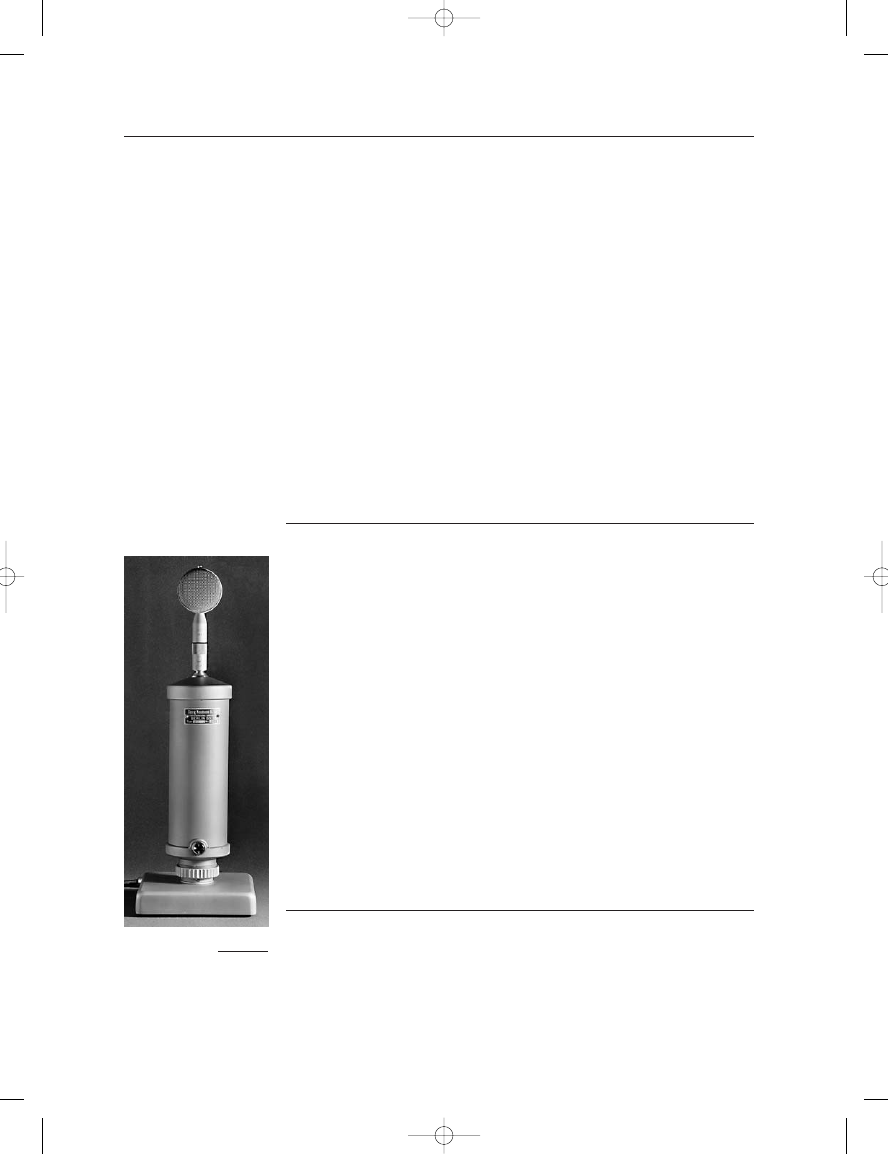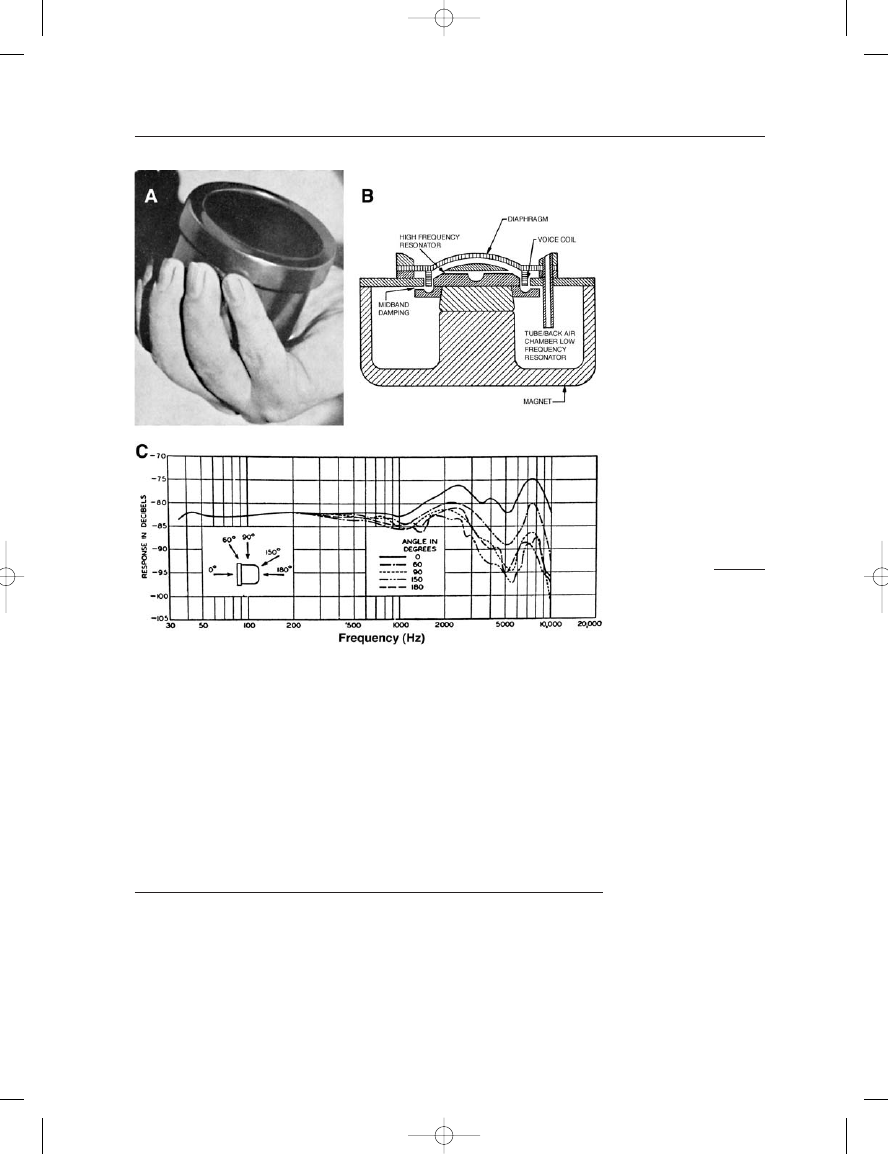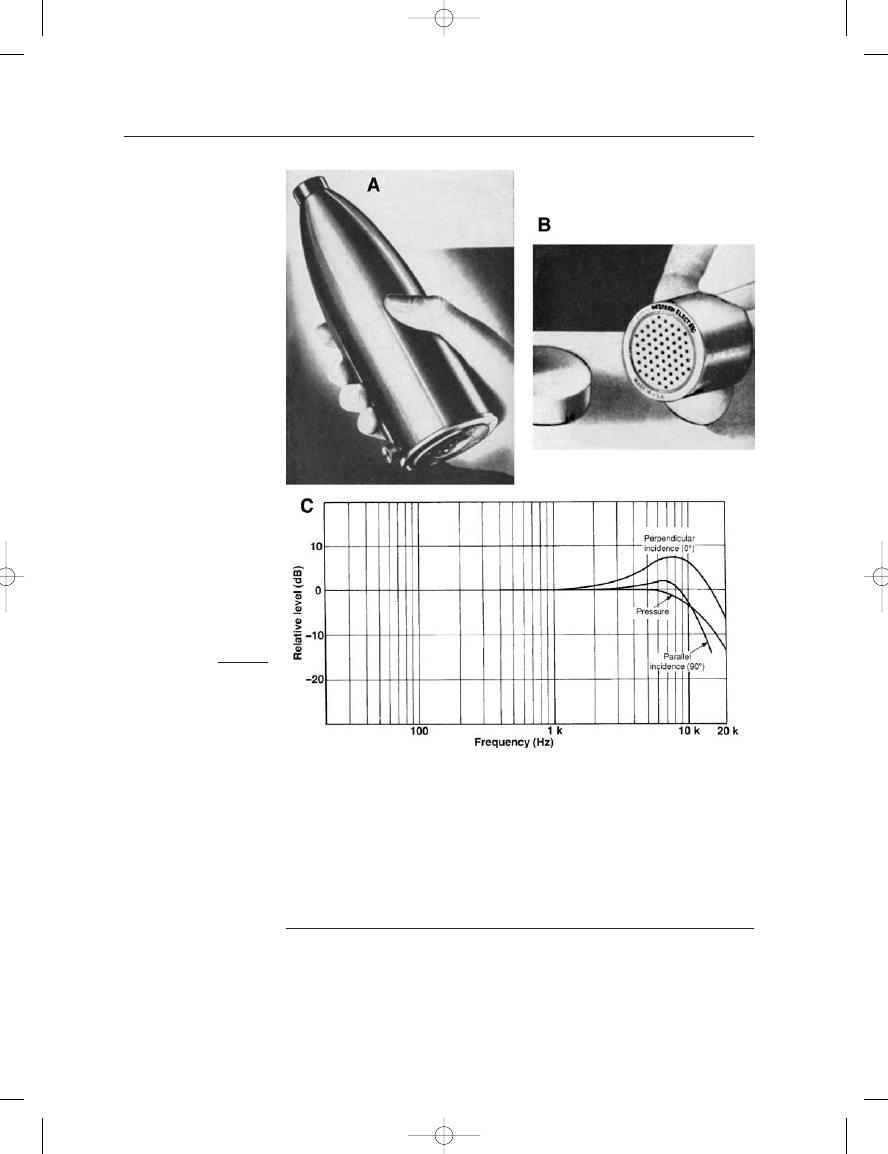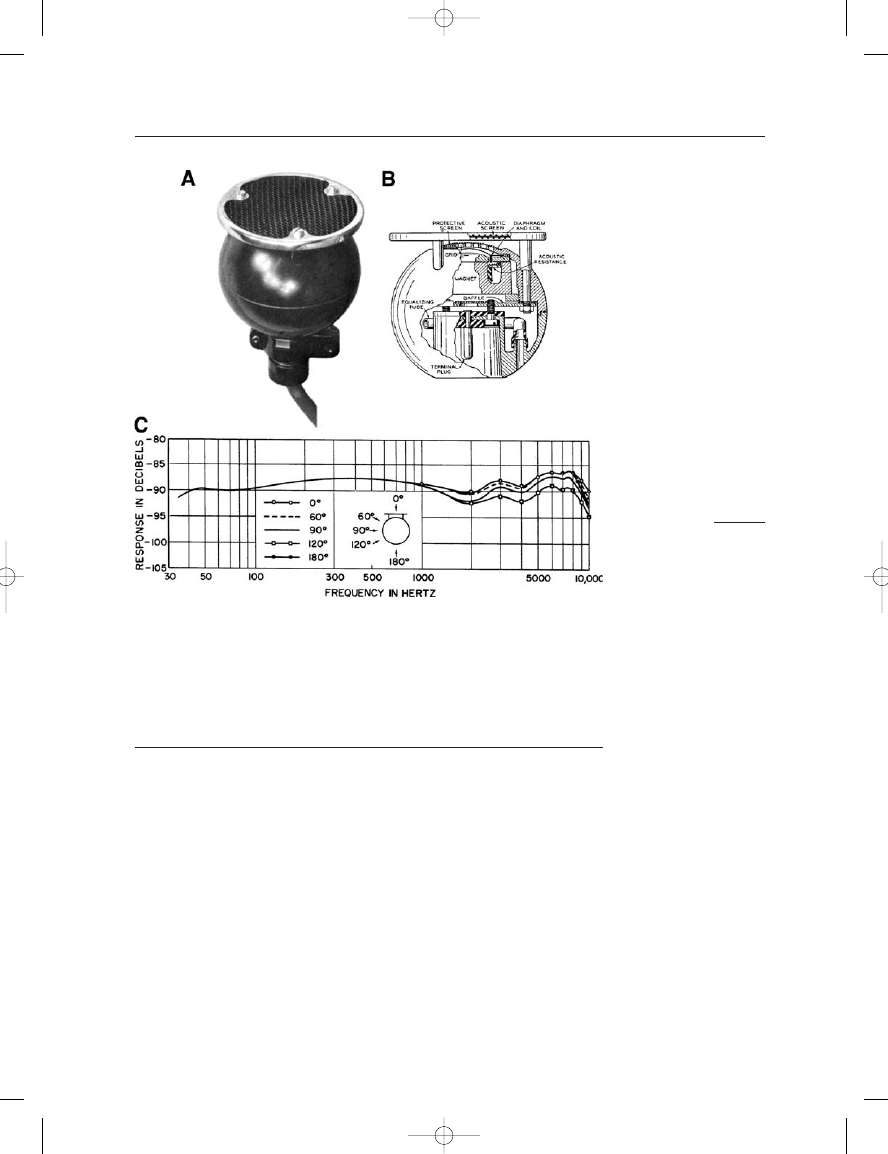ВУЗ: Казахская Национальная Академия Искусств им. Т. Жургенова
Категория: Книга
Дисциплина: Не указана
Добавлен: 03.02.2019
Просмотров: 17245
Скачиваний: 51

C
H
A
P
T
E
R
2
1
CLASSIC MICROPHONES:
THE AUTHOR’S VIEW
INTRODUCTION
This chapter was written as a result of numerous conversations with
both microphone users and manufacturers following publication of the
first edition of The Microphone Book. While the list reflects my personal
view of the subject, it should come as no surprise that it contains virtu-
ally all of the celebrated models of the last 75 years. Most engineers
would agree that the German and Austrian capacitor (condenser) models
introduced into the United States shortly after the Second World War
virtually reinvented both popular and classical recording in America, and
those models form the core of this presentation. To these I have added
the American contributions in dynamic and ribbon technology that
became the mainstay of broadcasting and communications in this country,
along with a group of fine omnidirectional capacitors that were also
distinctively American.
There are several independent criteria I have set for inclusion in
the list:
1. The microphone should be at least 30 years old and generally
regarded as an exemplar in its field. Some models are still in demand,
often at collectors’ traditionally high prices.
2. Microphones that have been at the vanguard of a particular design
or usage technology are also eligible, whether or not they have
attained wide renown.
3. Microphones that at an earlier time attained a unique cult following.
What I have in mind here are the aforementioned high-performance
American capacitor omnis that flowered in the early 1950s as part of
the burgeoning audiophile tape recording movement.
Earg_21.qxd 14/9/04 3:06 PM Page 338

21: Classic Microphones: The Author’s View
339
You might think that gathering photos and specifications of all of
these entries would have been a simple task. Not so. While I want to
thank many people for their permission to use photos of some of these
models, the bulk of the graphics in this chapter come from older publi-
cations and manufacturers’ original specification sheets, many of them
requiring all of the touchup wizardry that modern computer graphics
programs can provide. The presentation order is essentially chronologi-
cal, with occasional grouping of similar models that may be slightly out
of sequence.
Many of the entries show more than just a microphone. Response
curves, circuit diagrams, and control functions are also presented where
they underscore the performance of a given model.
This is as good a time as any to acknowledge the many avid authors,
designers, and historians who have embraced the subject of microphones
over the years. Their dedication to this fascinating field has kept a unique
history alive and vital for many of us – Abaggnaro, 1979; Bauer, 1987;
Knoppow, 1985; Paul, 1989; Sank, 1985; Webb, 1997; and Werner, 2002.
NEUMANN MODEL CMV3A
The stunning industrial design of this microphone takes its cue from the
German Bauhaus movement, and its realization in fine metal casting and
finishing is truly amazing for 1928 (Figure 21–1). While Wente’s omni-
directional capacitor design (Western Electric 1917) predates Georg
Neumann’s design by a decade, we must remember that American capac-
itors were virtually all omnidirectional until well after the Second World
War, whereas Neumann’s design included bidirectional and cardioid
elements based on the work of Braunmühl and Weber. Neumann’s work
in thin plastic material development and gold sputtering techniques pointed
the way for low mass diaphragms with extended response and high sensi-
tivity. You can hear a stereo pair of these microphones on a CD titled “Das
Mikrofon” (Tacet 17) in a performance of excerpts from a Haydn string
quartet. There is nothing “old” about the sound of these microphones.
Largely because of Neumann’s pioneering work, the European
broadcasting and recording communities adopted the capacitor micro-
phone early on in their pursuit of sonic excellence – a state of affairs that
would later position them favorably in the world market that developed
after the war.
WESTERN ELECTRIC MODEL 618
When broadcasting was introduced in 1919, carbon button microphones
were the mainstay of transmission in the studio. A few capacitors had also
made the grade, but their expense and technical requirements had pretty
much ruled them out for general use. The introduction of the Western
Electric 618 dynamic microphone was a breakthrough in that is was rugged
FIGURE 21–1
Neumann Model CMV3A.
(Photo courtesy of
Neumann/USA.)
Earg_21.qxd 14/9/04 3:06 PM Page 339

and, thanks to new cobalt-based magnet materials, had good sensitivity
and did not require a power supply. In essence it was the first dynamic
omnidirectional microphone, complete with all of the features that are
inherent in that design today. It had a midband-tuned highly damped
moving system complete with a resonance chamber for extended LF and
a small resonator behind the diaphragm for extended HF response.
Figure 21–2A shows the basic unit, and a cutaway view of the system is
shown at B. Typical on- and off-axis response curves are shown at C.
WESTERN ELECTRIC MODEL 640AA
Because of their extensive manufacturing of microphones for broadcast-
ing, motion picture sound, and recording, Western Electric had a need
for a highly stable calibration microphone. The introduction of the
640AA in 1932 provided this reference unit, and it soon became a stan-
dard for all electroacoustical manufacturing in the US. Even after Western
Electric ceased microphone manufacturing in the early 1950s, it retained
THE MICROPHONE BOOK
340
FIGURE 21–2
Western Electric Model 618
(A and C from Read, 1952;
B from Frayne and Wolfe,
1949.)
Earg_21.qxd 14/9/04 3:07 PM Page 340

21: Classic Microphones: The Author’s View
341
the manufacture of this model until the Danish Bruël & Kjær company
had attained sufficient stature in the instrumentation microphone field to
become the new standard. Figure 21–3A shows the 640AA unit mounted
on the RA-1095 preamplifier, and a close-up detail of the capsule is
shown at B. Typical response curves are shown at C.
WESTERN ELECTRIC MODEL 630
Introduced in the mid 1930s, the model 630, dubbed the “Eight Ball,”
improved on the performance of the 618. The new model was designed
to be used with its principal axis facing upward so that it had uniform
response over the entire 360
azimuthal plane. The spherical body design
FIGURE 21–3
Western Electric Model
640AA. (A and B from
Read, 1952; C from
National Bureau of
Standards, 1969.)
Earg_21.qxd 14/9/04 3:07 PM Page 341

contributed to the overall smoothness of response. Note that the 90
off-axis response is maintained within an envelope of
3 dB from 50 Hz
to 10 kHz.
WESTERN ELECTRIC MODEL 639
This famous model from the late 1930s represents Western Electric’s
only use of ribbon technology. In it, there are two elements: an omni
dynamic and a ribbon mounted directly above it. (See Figure 5–8 for
internal construction details.) While the RCA ribbons were corrugated
from top to bottom, the ribbon in the 639 was corrugated only at the top
and bottom, with the middle section crimped so that it moved as a unit.
Via external switching, the two acoustic elements could be operated
independently or combined in several ways to produce the family of first-
order cardioids. Figure 21–5A shows a view of the famous “bird cage”
design, typical on- and off-axis response curves are shown at B, C, and D
for three modes of response.
The model shown here bears the Altec brand name. By the mid
1950s, Western Electric ceased manufacturing commercial microphones,
giving that segment of their business to the Altec Corporation, which
THE MICROPHONE BOOK
342
FIGURE 21–4
Western Electric Model
630. (A and C from
Tremaine, 1969; B from
Read, 1952.)
Earg_21.qxd 14/9/04 3:07 PM Page 342